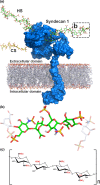The role of heparan sulphate in development: the ectodermal story
- PMID: 27385054
- PMCID: PMC4960573
- DOI: 10.1111/iep.12180
The role of heparan sulphate in development: the ectodermal story
Abstract
Heparan sulphate (HS) is ubiquitously expressed and is formed of repeating glucosamine and glucuronic/iduronic acid units which are generally highly sulphated. HS is found in tissues bound to proteins forming HS proteoglycans (HSPGs) which are present on the cell membrane or in the extracellular matrix. HSPGs influence a variety of biological processes by interacting with physiologically important proteins, such as morphogens, creating storage pools, generating morphogen gradients and directly mediating signalling pathways, thereby playing vital roles during development. This review discusses the vital role HS plays in the development of tissues from the ectodermal lineage. The ectodermal layer differentiates to form the nervous system (including the spine, peripheral nerves and brain), eye, epidermis, skin appendages and tooth enamel.
© 2016 The Authors. International Journal of Experimental Pathology © 2016 International Journal of Experimental Pathology.
Figures




References
-
- Ai X., Kitazawa T., Do A.T., Kusche‐Gullberg M., Labosky P.A. & Emerson C.P. Jr (2007) SULF1 and SULF2 regulate heparan sulfate‐mediated GDNF signaling for esophageal innervation. Development 134, 3327–3338. - PubMed
-
- Aikawa J. & Esko J.D. (1999) Molecular cloning and expression of a third member of the heparan sulfate/heparin GlcNAc N‐deacetylase/N‐sulfotransferase family. J. Biol. Chem. 274, 2690–2695. - PubMed
-
- Arikawa‐Hirasawa E., Watanabe H., Takami H., Hassell J.R. & Yamada Y. (1999) Perlecan is essential for cartilage and cephalic development. Nat. Genet. 23, 354–358. - PubMed
Publication types
MeSH terms
Substances
LinkOut - more resources
Full Text Sources
Other Literature Sources

